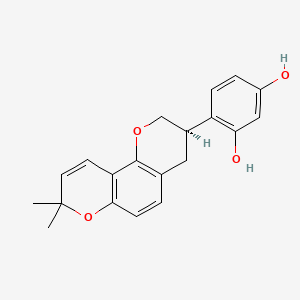| MeSH term | MeSH ID | Detail |
|---|---|---|
| Adenocarcinoma | D000230 | 166 associated lipids |
| Diabetes Mellitus, Experimental | D003921 | 85 associated lipids |
| Body Weight | D001835 | 333 associated lipids |
| Nephritis | D009393 | 19 associated lipids |
| Carcinoma, Non-Small-Cell Lung | D002289 | 72 associated lipids |
| Hyperpigmentation | D017495 | 11 associated lipids |
Glabridin
Glabridin is a lipid of Polyketides (PK) class. Glabridin is associated with abnormalities such as Atherosclerosis, CNS disorder, Corn of toe, Fatty Liver and Obesity. The involved functions are known as Energy Absorption, Oxidation, Oxidants, Metabolic Process, Cellular and Drug Interactions. Glabridin often locates in Hepatic, membrane fraction, Microsomes, Microsomes, Liver and Extracellular. The associated genes with Glabridin are P4HTM gene, SPEN gene, SLC33A1 gene, ABCB1 gene and CD9 gene. The related lipids are Nonesterified Fatty Acids, Total cholesterol, Lipopolysaccharides, Hydroxycholesterols and 7-ketocholesterol. The related experimental models are Mouse Model.
Cross Reference
Introduction
To understand associated biological information of Glabridin, we collected biological information of abnormalities, associated pathways, cellular/molecular locations, biological functions, related genes/proteins, lipids and common seen animal/experimental models with organized paragraphs from literatures.
What diseases are associated with Glabridin?
Glabridin is suspected in Obesity, Fatty Liver, Metabolic Diseases, Hyperlipidemia, Septicemia, Atherosclerosis and other diseases in descending order of the highest number of associated sentences.
Related references are mostly published in these journals:
| Disease | Cross reference | Weighted score | Related literature |
|---|
Possible diseases from mapped MeSH terms on references
We collected disease MeSH terms mapped to the references associated with Glabridin
PubChem Associated disorders and diseases
What pathways are associated with Glabridin
There are no associated biomedical information in the current reference collection.
PubChem Biomolecular Interactions and Pathways
Link to PubChem Biomolecular Interactions and PathwaysWhat cellular locations are associated with Glabridin?
Visualization in cellular structure
Associated locations are in red color. Not associated locations are in black.
Related references are published most in these journals:
| Location | Cross reference | Weighted score | Related literatures |
|---|
What functions are associated with Glabridin?
Related references are published most in these journals:
| Function | Cross reference | Weighted score | Related literatures |
|---|
What lipids are associated with Glabridin?
Related references are published most in these journals:
| Lipid concept | Cross reference | Weighted score | Related literatures |
|---|
What genes are associated with Glabridin?
Related references are published most in these journals:
| Gene | Cross reference | Weighted score | Related literatures |
|---|
What common seen animal models are associated with Glabridin?
Mouse Model
Mouse Model are used in the study 'Macrophage enrichment with the isoflavan glabridin inhibits NADPH oxidase-induced cell-mediated oxidation of low density lipoprotein. A possible role for protein kinase C.' (Rosenblat M et al., 1999) and Mouse Model are used in the study 'Glabridin, an isoflavan from licorice root, inhibits inducible nitric-oxide synthase expression and improves survival of mice in experimental model of septic shock.' (Kang JS et al., 2005).
Related references are published most in these journals:
| Model | Cross reference | Weighted score | Related literatures |
|---|
NCBI Entrez Crosslinks
All references with Glabridin
Download all related citations| Authors | Title | Published | Journal | PubMed Link |
|---|---|---|---|---|
| Li P et al. | Glabridin, an isoflavan from licorice root, ameliorates imiquimod-induced psoriasis-like inflammation of BALB/c mice. | 2018 | Int. Immunopharmacol. | pmid:29665498 |
| Chen CT et al. | Glabridin induces apoptosis and cell cycle arrest in oral cancer cells through the JNK1/2 signaling pathway. | 2018 | Environ. Toxicol. | pmid:29663662 |
| Wang Y et al. | Synergistic Promotion on Tyrosinase Inhibition by Antioxidants. | 2018 | Molecules | pmid:29300356 |
| Lee PH et al. | Glabridin inhibits the activation of myofibroblasts in human fibrotic buccal mucosal fibroblasts through TGF-β/smad signaling. | 2018 | Environ. Toxicol. | pmid:29119715 |
| Moazeni M et al. | Glabridin triggers over-expression of MCA1 and NUC1 genes in Candida glabrata: Is it an apoptosis inducer? | 2017 | J Mycol Med | pmid:28595940 |
| Wei Y et al. | Characterization of glabridin/hydroxypropyl-β-cyclodextrin inclusion complex with robust solubility and enhanced bioactivity. | 2017 | Carbohydr Polym | pmid:28038744 |
| Liu K et al. | Metabolomics Analysis To Evaluate the Anti-Inflammatory Effects of Polyphenols: Glabridin Reversed Metabolism Change Caused by LPS in RAW 264.7 Cells. | 2017 | J. Agric. Food Chem. | pmid:28644019 |
| Liu C et al. | Enhanced skin permeation of glabridin using eutectic mixture-based nanoemulsion. | 2017 | Drug Deliv Transl Res | pmid:28188607 |
| Mu J et al. | The repressive effect of miR-148a on Wnt/β-catenin signaling involved in Glabridin-induced anti-angiogenesis in human breast cancer cells. | 2017 | BMC Cancer | pmid:28464803 |
| Chakotiya AS et al. | Effect of aquo-alchoholic extract of Glycyrrhiza glabra against Pseudomonas aeruginosa in Mice Lung Infection Model. | 2017 | Biomed. Pharmacother. | pmid:28355591 |
